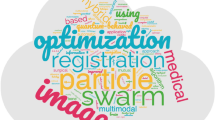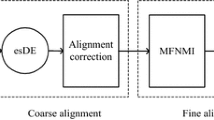Abstract
Image registration is an important aspect in medical image analysis, and kinds use in a variety of medical applications. Examples include diagnosis, pre/post surgery guidance, comparing/merging/integrating images from multi-modal like Magnetic Resonance Imaging (MRI), and Computed Tomography (CT). Whether registering images across modalities for a single patient or registering across patients for a single modality, registration is an effective way to combine information from different images into a normalized frame for reference. Registered datasets can be used for providing information relating to the structure, function, and pathology of the organ or individual being imaged. In this paper a hybrid approach for medical images registration has been developed. It employs a modified Mutual Information (MI) as a similarity metric and Particle Swarm Optimization (PSO) method. Computation of mutual information is modified using a weighted linear combination of image intensity and image gradient vector flow (GVF) intensity. In this manner, statistical as well as spatial image information is included into the image registration process. Maximization of the modified mutual information is effected using the versatile Particle Swarm Optimization which is developed easily with adjusted less parameter. The developed approach has been tested and verified successfully on a number of medical image data sets that include images with missing parts, noise contamination, and/or of different modalities (CT, MRI). The registration results indicate the proposed model as accurate and effective, and show the posture contribution in inclusion of both statistical and spatial image data to the developed approach.












Similar content being viewed by others
Explore related subjects
Discover the latest articles, news and stories from top researchers in related subjects.References
Hill, D. L. G., Batchelor, P. G., Holden, M. and Hawkes, D. J., Topical Review, Medical image registration. Phys. Med. Biol. (46), 2001.
Wyawahare, M. V., Patil, P. M., and Abhyankar, H. K., Image registration techniques: an overview. International Journal of Signal Processing, Image Processing and Pattern Recognition Vol. 2, No.3, 2009.
Zitova, B., Flusser, J., Image registration methods: a survey, Image and Vision Computing (21)977–1000, 2003.
Patel, P. M., Shah, V. M.. Image Registration Techniques: A Comprehensive Survey, International Journal of innovative research & development, 2014.
Viola, P. A., Alignment by Maximization of Mutual Information, Massachusetts Institute Of Technology Artificial Intelligence Laboratory A.I. Technical Report No. 1548, 1995.
Ulysses, J. N., Conci, A., Measuring Similarity in Medical Registration, 17th International Conference on Systems, Signals and Image Processing - IWSSIP 2010.
Mani, V. R. S., Arivazhagan, S., Survey of Medical Image Registration, Journal of Biomedical Engineering and Technology, 2013.
Deshmukh, S. M., Sonpimple, M. K., Giripunje, M. S., DEVELOPMENT OF TRADITIONAL OPTIMIZATION APPROACH FOR OPTIMAL SYNTHESIS OF PATH GENERATOR LINKAGE, International Journal of Engineering and Technical Research (IJETR) ISSN: 2321–0869, Volume-1, Issue-9, 2013.
Pluim, J.P.W., Antoine Maintz, J.B., and Viergever, M.A., Mutual information based registration of medical images: a survey. IEEE transactions on Medical Imaging. 22:986–1004, 2003.
Rundo, L., Tangherloni, A., Militello, C., Multimodal Medical Image Registration Using Particle Swarm Optimization: A Review, IEEE Symposium Series on Computational Intelligence (SSCI), 2016.
Eberhart, R. C. and Shi, Y., “Particle Swarm Optimization: Developments, Applications, and Resources,” Proceedings of IEEE Congress on Evolutionary Computation (CEC 2001), Korea, 2001.
Kennedy, J., Eberhart, R., and Shi, Y., Swarm Intelligence, Academic Press, 2001.
Special issue of IEEE Trans. on Evol. Computation on Particle Swarm Optimization, Vol. 8, No. 3, June, 2004.
Suganya, R., Priyadharsini, K., Rajaram, S., Intensity Based Image Registration by Maximization of Mutual Information, © International Journal of Computer Applications (0975–8887) Volume 1 – No. 20, 2010.
Huang, L., Li, Z., Feature-based image registration using the shape context, International Journal of Remote Sensing, 2010.
Tsai, D.M., and Lin, C.T., Fast normalized cross correlation for defect detection, Machine Vision Lab. Department of Industrial Engineering and Management, Yuan-Ze University, Chung-Li, Taiwan, R.O.C.
D’Agostino, E., Maes, F., Vandermeulen, D., and Suetens, P., A viscous fluid model for multimodal non-rigid image registration using mutual information. Medical Image Analysis. 7:565–575, 2003.
Roche, A., Maladain, G., Pennec, X., and Ayache, N., The Correlation Ratio As A New Similarity Measure For Multimodal Image Registration. EPIDAURE project. Springer, France, 2008.
Chumchob, N. and Chen, K., A Robust Affine Image Registration Method, International Journal OF Numerical Analysis And Modeling, Institute for Scientific Computing and Information 6, Number 2, 2009.
Ardeshir Goshtasby, A., Transformation Functions for Image Registration, Image Fusion Systems Research 2003.
Liao, X., Guo, S., Yin, J., Wang, H., Li, X., and Sangaiah, A.K., New cubic reference table based image steganography. Multimedia Tools and Applications, 2017. https://doi.org/10.1007/s11042-017-4946-9 PP 1–18.
Zhang, R., Shen, J., Wei, F., Li, X., and Sangaiah, A.K., Medical image classification based on multi-scale non-negative sparse coding. Artificial Intelligence in Medicine, 2017. https://doi.org/10.1016/j.artmed.2017.05.006.
Crum, W.R., Hartkens, T., and Hill, D.L.G., Non-rigid image registration: theory and practice. The British Journal of Radiology. 77:S140–S153, 2004.
Klein, S., Staring, M., and Pluim, J. P. W., Evaluation of Optimization Methods for Nonrigid Medical Image Registration Using Mutual Information and B-Splines, IEEE TRANSACTIONS ON IMAGE PROCESSING, VOL. 16, NO. 12, DECEMBER 2007.
Ch. Venkateswara Rao, A, Rao, K.M.M.A., Manjunath, A.S.A., Srinivas, R.V.N., Optimization Of Automatic Image Registration Algorithms And Characterization, PS Comission III,WG,III/8.
Gan, R., and Chung, A.C.S., Robust Optimization Using Disturbance for Image Registration. © Springer-Verlag, Berlin Heidelberg, 2006.
Xu, C., and Prince, J.L., Snakes, shapes, and gradient vector flow. IEEE Trans. on Image Process. 7(3):359–369, 1998.
C. Xu and J. L. Prince.Gradient Vector Flow Deformable Models Handbook of Medical Imaging, Editor: Isaac Bankman, Academic Press, 2000.
Kass, M., Witkin, A., and Terzopoulos, D., Snakes: Active contour models. International Journal of Computer Vision. 1(4):321–331, 1988.
Zhang, Y., Wang, S., & Ji, G. (2015). A comprehensive survey on particle swarm optimization algorithm and its applications. Mathematical Problems in Engineering, 2015.
Ayatollahi, F., Shahriar Baradaran Shokouhi, Ahmad Ayatollahi A new hybrid particle swarm optimization for multimodal brain image registration. J. Biomedical Science and Engineering. 5:153–161, 2012.
Chen, Y.W. and Mimori, A. ,Hybrid particle swarm optimization for medical image registration, Proceedings of the 5th International Conference on Natural Computation (ICNC), Tianjin, 14-16 2009, 26–30.
S. Periaswamy and H. Farid., Medical Image Registration with Partial Data. Medical Image Analysis, 10:452–464, Dartmouth College, Hanover, NH, 03755, 2006.
Birge, B., PSOt, A Particle Swarm Optimization Toolbox for Matlab, IEEE Swarm Intelligence Symposium Proceedings, 2003.
Wang, S., Phillips, P., Yang, J., Sun, P., and Zhang, Y., Magnetic resonance brain classification by a novel binary particle swarm optimization with mutation and time-varying acceleration coefficients. Biomedical Engineering/Biomedizinische Technik. 61(4):431–441, 2016.
Zhang, Y., Ji, G., Yang, J., Wang, S., Dong, Z., Phillips, P., and Sun, P., Preliminary research on abnormal brain detection by wavelet-energy and quantum-behaved PSO. Technology and Health Care. 24(s2):S641–S649, 2016.
Author information
Authors and Affiliations
Corresponding author
Ethics declarations
Conflict of Interest
The authors declared that we do not have any conflict of interest for this research work. This article does not contain any studies with human participants or animals performed by any of the authors.
Additional information
This article is part of the Topical Collection on Image and Signal Processing
Rights and permissions
About this article
Cite this article
Abdel-Basset, M., Fakhry, A.E., El-henawy, I. et al. Feature and Intensity Based Medical Image Registration Using Particle Swarm Optimization. J Med Syst 41, 197 (2017). https://doi.org/10.1007/s10916-017-0846-9
Received:
Accepted:
Published:
DOI: https://doi.org/10.1007/s10916-017-0846-9




